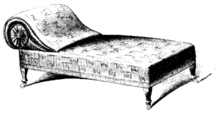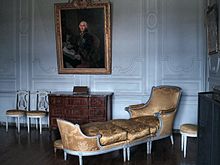- Chaise longue
-
"Lounge chair" redirects here. For the Swiss-French film, see Lounge Chair (film).
A chaise longue (French pronunciation: [ʃɛzlɔ̃ŋɡ(ə)], "long chair") is an upholstered couch in the shape of a chair that is long enough to support the legs.
It is sometimes erroneously written as "chaise lounge", which has persisted so strongly in the United States that it is no longer considered incorrect there, and can even be found in its dictionaries[1] (an example of folk etymology). In modern French the term chaise longue can refer to any long reclining chair such as a deckchair.
- Duchesse brisée (Broken duchess in French) : this word is used, when the chaise longue is divided in two parts : the chair and a long footstool. Or two chairs with a stool in between them [2]. The origin of the name is unknown.
- Récamier : a récamier has two raised ends, and nothing on the long sides. It is sometimes associated with French Empire (neo-classical) style. It’s named after French society hostess Madame Récamier (1777-1849), who posed elegantly on a couch of this kind. She had her portrait painted in 1800. The shape of the récamier is similar to a traditional lit bateau (boat bed) but made for the drawing room, not the bedroom [2].
- Méridienne : a méridienne has a high head-rest, and a lower foot-rest, joined by a a sloping piece. Whether or not they have anything at the foot end, méridiennes are asymmetrical day-beds. They were popular in the grand houses of France in the early 19th century. Its name is from its typical use —rest in the middle of the day, when the sun is near the meridian [2] [3].
See also
- Fainting couch
References
- ^ Questions & Answers: Chaise longue, Quinion, M. (2003)
- ^ a b c Is a recamier the same as a chaise longue? retrieved Feb 9, 2009
- ^ http://dictionary.reference.com/browse/meridienne
External links

This article about furniture or furnishing is a stub. You can help Wikipedia by expanding it.





